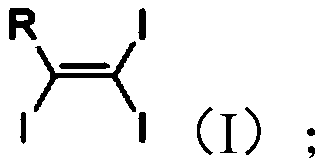A method for highly selective synthesis of 1,1,2-triiodoalkenes
A technology for triiodoalkenes and compounds, which is applied in the field of high-selectivity synthesis of 1,1,2-triiodoalkene compounds, can solve the problems of using metal catalysts, harsh reaction conditions, uncontrollable reactions, etc., and achieve mild reaction conditions, Ease of separation and purification, avoiding metal residue and toxicity
- Summary
- Abstract
- Description
- Claims
- Application Information
AI Technical Summary
Problems solved by technology
Method used
Image
Examples
Embodiment 1
[0037]
[0038] Dissolve 38 μL (0.3 mmol) of p-methylphenylacetylene and 133 mg (0.36 mmol) of tetrabutylammonium iodide (TBAI) in 1 mL of acetonitrile, and add 96.6 mg (0.3 mmol) of iodobenzenediacetic acid to the In the reaction system, after reacting at room temperature for 3 hours, directly add 3 mL of water and 124.5 mg (0.75 mmol) of potassium iodide to the reaction system, and then add 193.2 mg (0.6 mmol) of iodobenzenediacetic acid into the reaction system in batches within 20 min , reacted at room temperature for 3 h, quenched the reaction with sodium thiosulfate, extracted three times with ethyl acetate, combined the organic phases and concentrated under reduced pressure to obtain the crude product 1. The crude product 1 was separated and purified by silica gel column chromatography (n-hexane 100%) to obtain a light-colored solid product 1 with a yield of 94%. With p-nitroacetophenone as the NMR internal standard, its NMR data are as follows:
[0039] 1 H NMR (4...
Embodiment 2
[0042]
[0043] Dissolve 38.9 μL (0.3 mmol) of 4-methoxyphenylacetylene and 133 mg (0.36 mmol) of tetrabutylammonium iodide in 1 mL of acetonitrile, and add 96.6 mg (0.3 mmol) of iodobenzenediacetic acid to the In the reaction system, after reacting at room temperature for 3 hours, directly add 3 mL of water and 124.5 mg (0.75 mmol) of potassium iodide to the reaction system, and then add 193.2 mg (0.6 mmol) of iodobenzenediacetic acid into the reaction system in batches within 20 min , reacted at room temperature for 3 h, quenched the reaction with sodium thiosulfate, extracted three times with ethyl acetate, combined the organic phases and concentrated under reduced pressure to obtain the crude product 2. The crude product 2 was separated and purified by silica gel column chromatography (n-hexane 100%) to obtain the light yellow solid product 2 with a yield of 90%. With p-nitroacetophenone as the NMR internal standard, its NMR data are as follows:
[0044] 1 H NMR (400M...
Embodiment 3
[0047]
[0048] Dissolve 33 μL (0.3 mmol) of phenylacetylene and 133 mg (0.36 mmol) of tetrabutylammonium iodide in 1 mL of acetonitrile, and add 96.6 mg (0.3 mmol) of iodobenzenediacetic acid into the reaction system in batches within 20 min. After reacting for 3 hours under the same conditions, directly add 3 mL of water and 124.5 mg (0.75 mmol) of potassium iodide to the reaction system, then add 193.2 mg (0.6 mmol) of iodobenzenediacetic acid into the reaction system in batches within 20 min, and react at room temperature 12h, and then add 124.5mg (0.75mmol) potassium iodide and 193.2mg (0.6mmol) iodobenzenediacetic acid to the reaction system, iodobenzenediacetic acid is added to the system in batches within 20min, react at room temperature for 6h and use The reaction was quenched with sodium thiosulfate, and then extracted three times with ethyl acetate. The organic phases were combined and concentrated under reduced pressure to obtain the crude product 3. The crude p...
PUM
 Login to View More
Login to View More Abstract
Description
Claims
Application Information
 Login to View More
Login to View More - R&D
- Intellectual Property
- Life Sciences
- Materials
- Tech Scout
- Unparalleled Data Quality
- Higher Quality Content
- 60% Fewer Hallucinations
Browse by: Latest US Patents, China's latest patents, Technical Efficacy Thesaurus, Application Domain, Technology Topic, Popular Technical Reports.
© 2025 PatSnap. All rights reserved.Legal|Privacy policy|Modern Slavery Act Transparency Statement|Sitemap|About US| Contact US: help@patsnap.com



